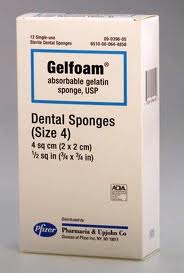
Surgeons and dentists often use Gelfoam sponges to mop up blood and help stop bleeding. Could they act as drug-eluting devices to grow new heart tissue?
While current heart-attack treatments mainly try to preserve healthy heart tissue, scientists have been finding ways to stimulate growth of new tissue to replace the tissue that’s damaged. They’ve done this either by getting heart muscle cells (cardiomyocytes) to make more copies of themselves, or by stimulating other cells to become cardiomyocytes (one recently reported study, for example, used genetic regulators called microRNAs).
The next challenge lies in getting these regenerative factors into a living patient’s damaged heart tissue — without affecting healthy tissue – and getting the factors to stay in place long enough to work their magic.
A new approach developed at Boston Children’s Hospital, which could be used relatively soon, takes advantage of Gelfoam, a gelatin-based sponge that’s already FDA-approved and has been used by surgeons and dentists for decades.
Cardiologist Bernhard Kühn, MD, and bioengineer Brian Polizzotti, PhD, decided to soak it in a peptide (that is, an abbreviated form) of periostin, a naturally occurring compound derived from the skin around bone. Back in 2007, Kühn’s lab showed that periostin effectively regenerates heart tissue, reduces scarring and improves heart function in rats.
Moving to a large-animal model, Kühn, Polizzotti and colleagues injected the Gelfoam-peptide mixture into the sac that surrounds the heart. “We used the pericardial sac like a containment center,” Polizzotti says.
The next hurdle was to get the Gelfoam to release the periostin peptide gradually, without the drug being washed away or broken down. To do this, they took advantage of the fact that whenever Gelfoam comes in contact with a body fluid, like that inside the pericardial sac, a clot forms around it. It’s a first-line immune response that shields the body from something that might be harmful. (Though this might sound alarming, the clot never enters a blood vessel so poses no medical risk.)
“We used the body’s innate ability to respond to Gelfoam in this way to encapsulate the drug,” Polizzotti explains. “That enables the drug to be released over time and exert its beneficial effect.”
Using this method, Kühn and Polizzotti were able to prolong the periostin peptide’s release so that it occurred gradually over the course of seven days after a heart attack. The treatment appeared safe: As reported last week in the online journal PLoS One, there was no inflammatory response and no scarring in the heart.
The researchers also showed that the drug diffuses rapidly through injured but not healthy heart tissue, decreasing the potential for adverse reactions. That’s because after a heart attack, the damaged heart muscle becomes more permeable, allowing periostin peptide to diffuse into the injured area.
In practical terms, the most important advantage of this drug-delivery approach is that it uses established medical procedures and FDA-approved devices, clearing some of the hurdles in getting it to heart patients. In the future, Kühn also hopes to use it to strengthen the hearts of children with congenital heart disease.
“Our objective was to demonstrate a clinically translatable strategy for targeted, prolonged release of periostin peptide in the heart,” says Kühn. “Our approach may also serve as a platform for rapid testing of new pharmaceuticals targeting the heart.”







